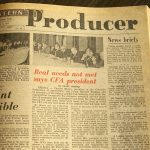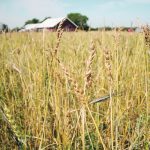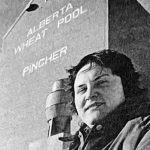In the early 1970s, two things were very apparent: the changing attitude toward women in society and the need for prairie farmers to reduce their dependency on cereal grain crops. Among the news stories of 1971, an article by Catherine Shorten, in the Jan. 6, 1972, issue of The Western Producer, revealed that the world […] Read more
Tag Archives WP100

Look back at the Feb. 22, 1973, issue
For the next year, this column will mark The Western Producer’s 100th anniversary by taking a deep dive every week into a past issue of the paper. The Saskatchewan government’s intention to significantly increase irrigation capacity around Lake Diefenbaker has been the talk of the province the last couple years. Proponents often claim that the […] Read more

Documentary remembers black cowboy legend from Alta.
A former American slave who became an Alberta icon because of his skills as a cowboy and rancher helped inspire a black filmmaker to understand her own place in the real history of Western Canada. “It was very confusing for me as a child to be aware that black roots in the country were long […] Read more

Look back at the Feb. 18, 1971, issue
For the next year, this column will mark The Western Producer’s 100th anniversary by taking a deep dive every week into a past issue of the paper. Supply management coverage continues to use up a lot of ink at The Western Producer, so it was interesting to watch in the Feb. 18, 1971, issue as […] Read more

Look back at the Feb. 6, 1969, issue
For the next year, this column will mark The Western Producer’s 100th anniversary by taking a deep dive every week into a past issue of the paper. One thing I’ve noticed while reading through old copies of The Western Producer is that the paper didn’t do a lot of practical, production-oriented on-farm stories back in […] Read more

The seed that changed Canada’s wheat industry
WINNIPEG — For more than a century, Canadian wheat has been sold, promoted and exported around one virtue: it produces top quality flour and bread. Thanks to breeding innovations and good fortune, Canadian wheat has set the global standard for high-quality milling wheat for about 120 years. The strong relationship between Canadian wheat and high […] Read more

Look back at the Feb. 2, 1967, issue
For the next year, this column will mark The Western Producer’s 100th anniversary by taking a deep dive every week into a past issue of the paper. A story in the Feb. 2, 1967, issue provided a good example of how politicians can sidestep a controversy simply by ignoring it. It’s a skill many modern […] Read more

Centennial good reason to reflect on nation’s food history
Canada’s 100th birthday in 1967 seemed to be an appropriate time to explore and enjoy the exciting recipes that made up the Canadian cuisine culture. Emmie Oddie’s “I’d Like To Know?” column in The Western Producer received numerous request for recipes that reflected this heritage for use at centennial buffets, family gatherings and picnics. One […] Read more

Look back at the Jan. 28, 1965, issue
For the next year, this column will mark The Western Producer’s 100th anniversary by taking a deep dive every week into a past issue of the paper. One of the big stories in the Jan. 28, 1965, issue was about a significant wheat sale to China. The Canadian Wheat Board was reporting that the Asian […] Read more

The 1960s were a decade of rapid change on the Prairies
The gradual changes that had started in the farm population in the 1950s accelerated in the 1960s. Farms and the equipment were getting larger and developments in fertilizers, herbicides and new plant varieties increased productivity. Farm youth obtained post-secondary education and were seeking employment away from the farm. A trend toward specialization reduced the number […] Read more






